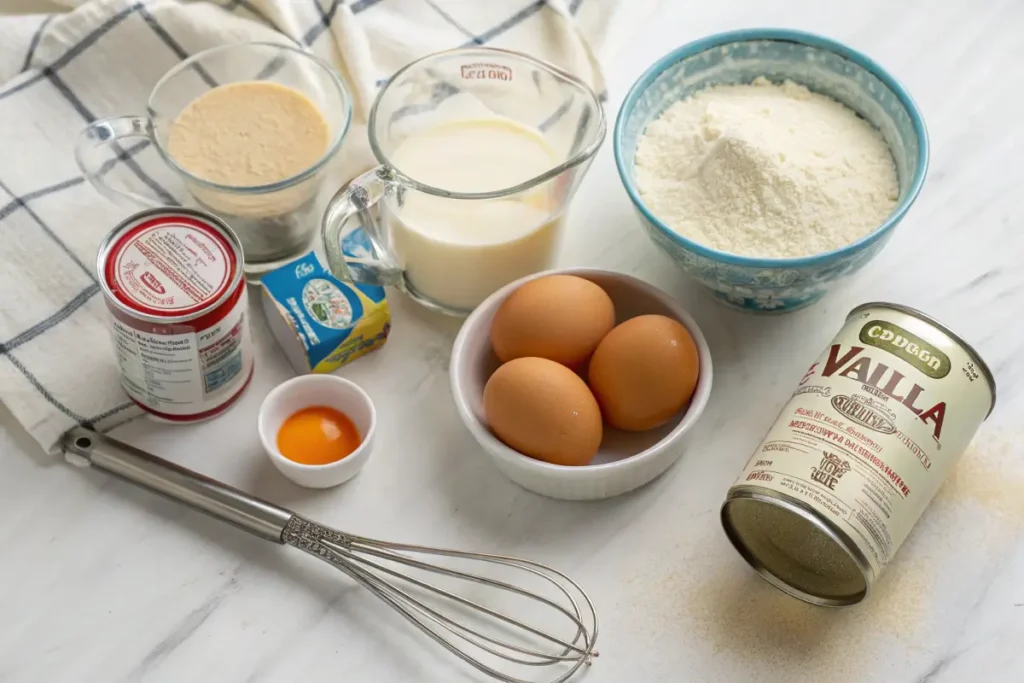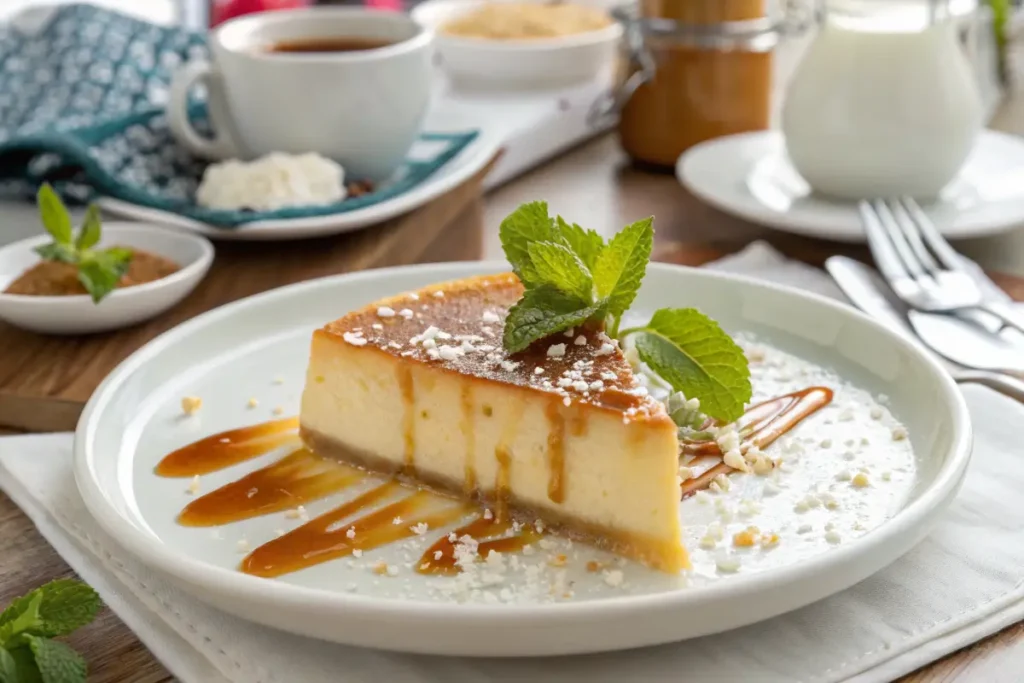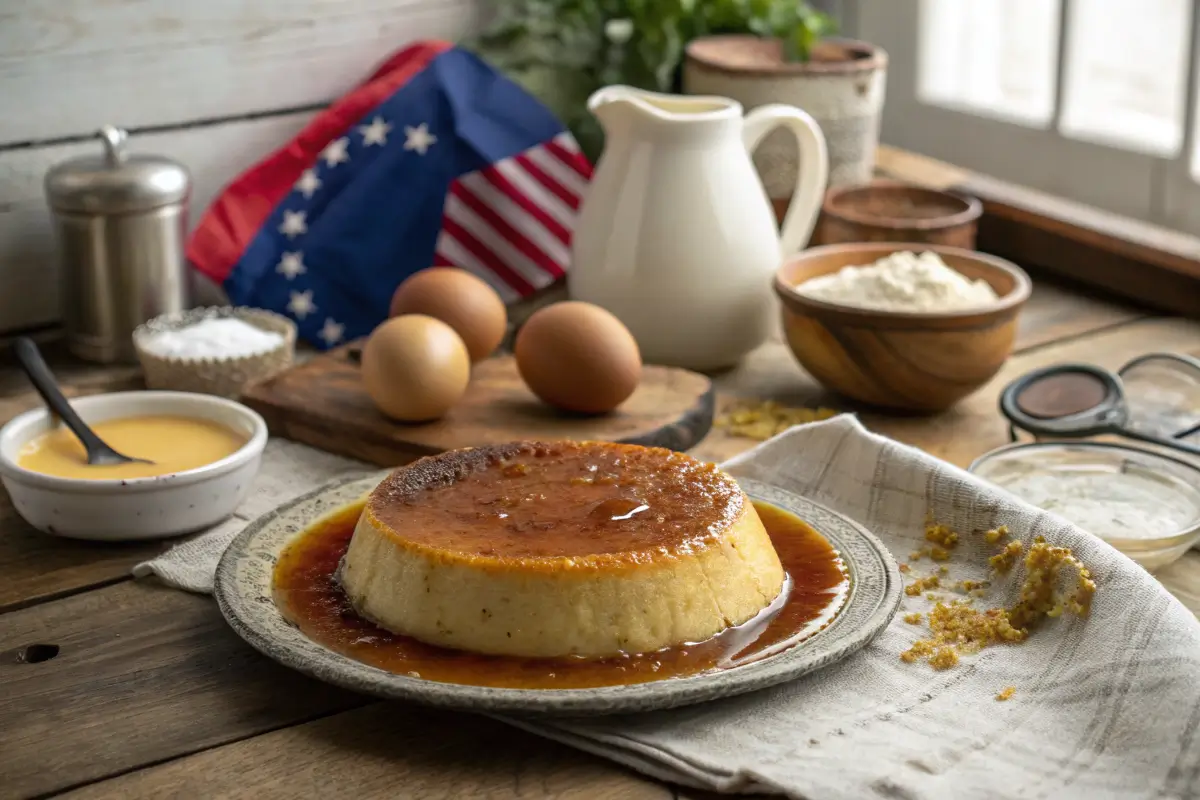Introduction to Quesillo
What is Quesillo?
Quesillo is a traditional Venezuelan dessert that looks a lot like flan but has its own unique charm. It’s made with simple ingredients like eggs, condensed milk, whole milk, and sugar. The name “quesillo” means “little cheese,” but don’t be fooled there’s no actual cheese in it! The name comes from the dessert’s texture, which is creamy and slightly airy, thanks to the way the egg whites and yolks mix during baking. If you’ve never tried quesillo, you’re seriously missing out on a slice of heaven.
A Brief History of Quesillo in Venezuelan Cuisine
Quesillo has deep roots in Venezuelan culture, often served during celebrations and family gatherings. Its history ties back to the colonial era when European culinary traditions blended with local flavors. Over the years, it’s become a staple dessert across the country, with each region adding its own twist. For many Venezuelans, quesillo is more than just a dessert; it’s a symbol of home, comfort, and shared memories.
Ingredients for Making Quesillo
Essential Ingredients for a Classic Quesillo

The beauty of quesillo is in its simplicity. You’ll need just a handful of ingredients to create its luscious texture and caramel goodness. Here’s what you’ll need:
- 5 large eggs
- 1 can (14 ounces) of sweetened condensed milk
- 1 can of whole milk (use the empty condensed milk can as your measure)
- 1 cup of sugar (for the caramel)
- 1 teaspoon of vanilla extract (optional, but it adds a lovely flavor)
These basic ingredients form the foundation of a classic quesillo. Don’t skip the caramel—it’s what gives quesillo its signature glossy top and sweet bite.
Variations: Coconut, Rum, and Other Flavors
While the traditional quesillo recipe is a crowd-pleaser, there are plenty of ways to mix it up. Some popular variations include adding coconut milk or shredded coconut for a tropical twist. A splash of rum can bring a warm, boozy note that’s perfect for special occasions. You could even try infusing the custard with spices like cinnamon or nutmeg for a seasonal flavor. The possibilities are endless, but the heart of the dessert always stays true to the essence of quesillo.
Tools and Equipment Needed
Choosing the Right Flan Mold
The right flan mold, or “quesillera,” can make all the difference when preparing quesillo. A traditional quesillera is a round, lidded metal mold, but you can use any similar baking dish. Just make sure it’s heatproof and deep enough to hold the caramel and custard mixture. If you don’t have a specific mold, a glass or ceramic dish works too, though the caramel might not release as easily.
Other Useful Kitchen Tools
To make quesillo, you’ll also need a few basic kitchen tools:
- A whisk or blender for mixing the custard
- A saucepan for making the caramel
- A roasting pan or large baking dish for the water bath
- Aluminum foil to cover the mold
- A cooling rack to let your quesillo set properly
These tools are simple but essential for getting that perfect quesillo texture and flavor.
The Step-by-Step Process of Making Quesillo
Preparing the Caramel Base
The caramel is the first step in making quesillo, and it’s where all the magic begins. Start by melting sugar in a saucepan over medium heat until it turns a rich golden brown. Be patient and stir gently to avoid burning. Once it’s ready, carefully pour the caramel into your mold, tilting it so the entire bottom is coated. Set it aside to cool while you prepare the custard.
Mixing the Custard Ingredients
Making the custard for quesillo is as simple as whisking everything together. Combine the eggs, condensed milk, whole milk, and vanilla extract in a bowl or blender. Mix until smooth, but don’t overdo it too much air can create bubbles in the finished dessert. The custard should be silky and well blended.
Assembling and Preparing for Baking
Once your caramel is set and your custard is mixed, it’s time to assemble your quesillo. Pour the custard mixture over the hardened caramel in your mold. Cover the mold tightly with aluminum foil or its lid. Place the mold in a water bath by setting it inside a larger roasting pan filled with hot water. The water should reach halfway up the sides of the mold. This method ensures the quesillo cooks evenly and stays creamy.
Quesillo is a dessert that’s simple to make yet rich in flavor and tradition. Its ingredients are easy to find, and the tools required are probably already in your kitchen. With a little patience and care, you’ll have a delicious homemade quesillo that’s perfect for sharing or keeping all to yourself!
Cooking Methods for Quesillo
Traditional Oven Baking
When it comes to making quesillo, baking it in the oven is the most traditional method. Start by preheating your oven to 350°F (175°C). Place your flan mold in a water bath, ensuring the water reaches about halfway up the sides of the mold. This gentle cooking process helps the quesillo cook evenly without drying out. Bake for about 50-60 minutes, or until the custard is set but still jiggles slightly in the center. Trust me, this method gives your quesillo that classic smooth texture everyone loves.
Stovetop Water Bath Method
If you don’t have access to an oven or just want to try something different, you can cook your quesillo on the stovetop using a water bath. This method is particularly popular in smaller kitchens. Place your mold inside a large pot with a lid. Add enough water to reach halfway up the mold and cover the pot tightly. Cook over medium-low heat for about an hour. Keep an eye on the water level and add more if it starts to evaporate. The result? A perfectly steamed quesillo that’s just as delicious as the baked version.
Using a Pressure Cooker
For those who love a quicker cooking process, a pressure cooker is a game-changer. Place your mold inside the cooker and add water as you would for the stovetop method. Seal the lid and cook on low pressure for about 20-25 minutes. Let the pressure release naturally before opening the cooker. This method saves time while still delivering a creamy, indulgent quesillo. Bonus: It’s great for busy weeknights or last-minute desserts!
Perfecting the Art of Caramelization
Tips for Achieving a Smooth and Even Caramel Layer
Let’s talk about caramel—arguably the most important part of quesillo. The key to perfect caramel is patience. Melt the sugar over medium heat, stirring gently until it turns a golden amber color. Avoid rushing this step, as high heat can burn the sugar and leave a bitter taste. Once the caramel is ready, pour it into your mold and swirl it around quickly to coat the bottom evenly. Let it cool and harden before adding the custard. Done right, the caramel will create a glossy, sweet topping when you unmold your quesillo.
Avoiding Common Caramelization Mistakes
Caramel can be tricky, but a few simple tricks can save you from common pitfalls. First, use a heavy-bottomed pan to prevent hot spots that can burn the sugar. Second, don’t walk away—caramel can go from perfect to burnt in seconds. Lastly, resist the urge to add water or stir too much once the sugar starts melting. These small adjustments will help you get that perfect caramel for your quesillo every time.
“If you want to refine your caramel techniques, learn how to make a crème brûlée top to perfect that golden finish.”
Serving and Presentation
How to Serve Quesillo Like a Pro

Serving quesillo is an art in itself. Once your quesillo has cooled completely, run a knife around the edges to loosen it. Place a serving plate over the mold and carefully invert it. The caramel should cascade down the sides, creating a picture-perfect finish. For an elegant touch, slice the quesillo into neat portions and serve with a dollop of whipped cream or fresh fruit. Whether you’re hosting a dinner party or just treating yourself, presenting your quesillo this way will impress every time.
Garnishing Ideas for an Elegant Finish
Want to take your quesillo to the next level? Garnishing is the way to go. Fresh berries like strawberries or raspberries add a pop of color and a tangy contrast to the sweet custard. A sprinkle of toasted coconut or crushed nuts brings texture and flavor. For a more decadent twist, drizzle a little chocolate sauce or caramel over the top. Whatever you choose, a simple garnish can make your quesillo look as good as it tastes.
The Nutritional Aspect of Quesillo
Caloric Breakdown of the Classic Recipe
Let’s be real—quesillo isn’t exactly a low-calorie dessert, but it’s worth every bite. A typical serving contains about 250-300 calories, depending on the size of the portion and the specific ingredients you use. Most of the calories come from the condensed milk and sugar, but the eggs and milk also add a good amount of protein and fat. It’s a rich dessert, so a small slice is often enough to satisfy your sweet tooth.
Adjustments for a Healthier Version
If you’re looking to lighten up your quesillo, there are a few simple swaps you can make. Use low-fat or plant-based milk instead of whole milk. Substitute a sugar-free condensed milk for the regular version, and try using a sugar alternative like stevia or erythritol for the caramel. These adjustments can significantly cut down on calories and sugar without compromising too much on flavor. Remember, though—quesillo is meant to be a treat, so don’t stress over perfection!
Storing and Reheating Quesillo
Best Practices for Refrigeration
Quesillo tastes even better after it’s been chilled, making refrigeration a must. Store your quesillo in its mold, tightly covered with plastic wrap or foil, to keep it fresh. It can last up to five days in the fridge, though it’s unlikely to stick around that long—it’s just too delicious to resist! If you’ve already unmolded it, cover it with plastic wrap to prevent the caramel from drying out.
Tips for Maintaining Texture When Reheating
While quesillo is typically served cold, you can reheat it gently if you prefer it warm. Place individual slices in a microwave-safe dish and heat for 10-15 seconds. Be careful not to overheat, as the custard can lose its creamy texture. A warm quesillo with melted caramel is an entirely different kind of indulgence—perfect for those cozy evenings when you need a little extra comfort.
Troubleshooting Common Issues
Why Your Quesillo Might Crack
Cracking can happen if your quesillo cooks at too high a temperature or for too long. To avoid this, always use a water bath and keep an eye on your cooking time. Another trick is to let the quesillo cool gradually after cooking—sudden temperature changes can cause cracks too. Even if it cracks, don’t worry—it’ll still taste amazing!
Solving Texture Inconsistencies
Is your quesillo too dense or full of bubbles? These texture issues are usually caused by overmixing the custard or cooking at an uneven temperature. To fix this, mix the custard ingredients gently and ensure your water bath is properly set up. With a little practice, you’ll master the art of making perfectly smooth quesillo every time.
Quesillo is a dessert that’s as much about the process as it is about the final result. From cooking methods to presentation tips, there are countless ways to make your quesillo stand out. With this guide, you’ll be able to cook, serve, and troubleshoot quesillo like a true pro. So, what are you waiting for? Dive in and let the caramel magic begin!
The Cultural Significance of Quesillo
How Quesillo Brings Families Together
For Venezuelan families, quesillo is much more than just a dessert—it’s a tradition that brings people together. Whether it’s served at birthdays, Christmas dinners, or casual Sunday lunches, quesillo has a way of making any gathering feel special. The act of preparing quesillo often becomes a group effort, with one person melting the caramel and another whisking the custard. It’s a dessert that fosters connection, laughter, and shared memories around the table.
In many households, recipes for quesillo are passed down through generations, each family adding their own twist. Some use a splash of rum for an extra kick, while others stick to the classic vanilla flavor. No matter the variation, quesillo represents love, family, and the joy of sharing food with those who matter most.
Quesillo as a Celebration Dessert
If there’s one thing Venezuelans know how to do, it’s celebrate, and quesillo is almost always on the menu. From weddings to graduations, this caramel-topped delight is a must-have at any festive occasion. Its smooth, creamy texture and rich flavor make it a crowd favorite that pairs perfectly with other traditional dishes like hallacas and pan de jamón.
Quesillo also holds a special place during Christmas. Many families include it in their holiday feasts, alongside fruitcake and other sweet treats. Its caramel top glistens like a festive decoration, making it the star of the dessert table. Whether it’s a grand celebration or a quiet evening at home, quesillo adds a touch of sweetness to any moment worth cherishing.
Exploring Global Variations of Flan
Comparing Quesillo with Classic Flan Recipes
At first glance, quesillo and flan might seem like the same dessert. Both feature a creamy custard base topped with caramel, but the similarities end there. Quesillo, with its distinctive texture, stands apart thanks to the way it incorporates whole eggs. Unlike classic flan, which often uses just yolks for a denser consistency, quesillo includes egg whites, giving it an airy, almost sponge-like feel.
Another key difference is the sweetness level. Quesillo tends to be slightly richer in flavor, thanks to the condensed milk, while traditional flan leans more toward a subtle, egg-forward taste. These small but important distinctions make quesillo a unique dessert that holds its own on the world stage of custards.
Unique Regional Takes on Similar Desserts
Every culture seems to have its own version of flan, and each one offers a glimpse into its culinary heritage. In Mexico, for example, flan is often infused with cinnamon or coffee for a warm, aromatic twist. In the Philippines, leche flan is made with an extra dose of egg yolks and sugar, resulting in a denser, richer treat.
In Puerto Rico, tembleque takes a coconut-based spin, while in France, crème caramel showcases a more delicate texture with a buttery caramel topping. Despite these regional differences, quesillo holds its place as a proud Venezuelan treasure, with a flavor and texture that stand out in the crowded world of custard desserts.
“For another take on custard-like desserts, check out this article on what Mexican cheesecake is made of and see how it differs from quesillo.”
FAQs About Quesillo
What is the meaning of quesillo?
The word “quesillo” translates to “little cheese” in Spanish, but don’t let the name fool you—there’s no cheese in this dessert. The name refers to its texture, which resembles that of a soft, airy cheese due to the inclusion of egg whites in the recipe.
Is quesillo the same as mozzarella?
No, quesillo and mozzarella are entirely different. While mozzarella is a savory cheese commonly used on pizzas and in Italian dishes, quesillo is a sweet dessert similar to flan. The only similarity lies in the name and the slightly airy texture of quesillo, which might remind some of soft cheeses.
What’s the difference between queso and quesillo?
In Spanish, “queso” simply means cheese, while “quesillo” refers to the dessert. In some Latin American regions, quesillo can also mean a type of cheese, but in Venezuela, it’s almost exclusively associated with the beloved caramel-topped custard. So, while queso and quesillo share a linguistic root, they’re used to describe very different things.
What does quesillo taste like?
Quesillo has a rich, creamy flavor with just the right amount of sweetness. The caramel topping adds a bittersweet depth that perfectly balances the smooth custard. The texture is light and slightly spongy, making it a dessert that feels indulgent yet not overly heavy. If you’ve ever had flan, imagine it with a touch more richness and a silky finish—that’s the magic of quesillo.
Conclusion
Why Quesillo is More Than Just a Dessert
Quesillo is more than a recipe; it’s a story of family, tradition, and celebration. Each bite carries the warmth of shared memories, the joy of gatherings, and the pride of Venezuelan culture. Whether you’re enjoying it for the first time or passing down a family recipe, quesillo has a way of making every moment sweeter.
Encouragement to Try Making Quesillo at Home
If you’ve never made quesillo before, now’s the perfect time to give it a shot. With just a few ingredients and simple techniques, you can create a dessert that’s as beautiful as it is delicious. So gather your tools, invite some friends or family, and start a new tradition with quesillo. Who knows? It might just become your go-to dessert for every celebration.


2 thoughts on “Quesillo: 7 Sweet Reasons to Love Venezuela’s Traditional Dessert”